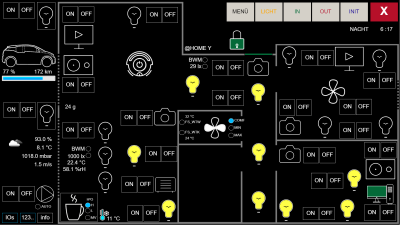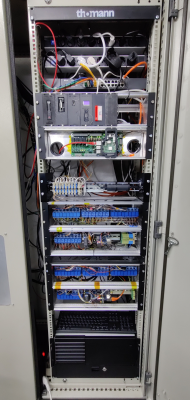
Supervisory control and data acquisition, or SCADA, systems sit in the background in industrial settings, performing all kinds of important jobs but in an ad-hoc setup, depending on the precise requirements of the installation. When we think about home automation systems, they’re pretty much the same deal: ad-hoc systems put together from off-the-shelf components and a few custom bits thrown in. [Stefan Schnitzer] clearly has significant knowledge of SCADA in an industrial setting and has carried this over into their home for their entry into the Hackaday 2024 Home Sweet Home Automation Contest.
Having built their own home from the ground up, [Stefan] could run wiring and add sensors anywhere needed whilst working on the interior, giving a clean, full custom installation covering lights, heating, ventilation, even the robot vacuum cleaner and the cat feeder. No dodgy conduits and visible wiring runs!
the robot vacuum cleaner and the cat feeder. No dodgy conduits and visible wiring runs!
SCADA systems are designed in a hierarchical manner, which makes them easy to understand. At the bottom of the hierarchy, which is level 0, we have the physical variables and control mechanisms that include things like room temperature control, door lock status and the cat feeder. Above this is level 1, the physical interface between levels 0 and 2. This level 1 hardware is based around a collection of Arduino UNOs and Mega2560s, keeping costs low. One extra, fancy addition was a Pixtend I/O board, which connects directly to the level 2 hardware, a Raspberry Pi3, which forms the SCADA supervisor and runs the web server for direct low-level control, as well as the Modbus TCP driver for the ethernet modules used on the Arduinos. This Pi also runs the MQTT broker and the Codesys software PLC. Finally, levels 3 and 4 are the coordination/production layers and are implemented with another Raspberry Pi3 that runs NodeRed and Grafana. InfluxDB is used for local data storage. This Pi also receives images from the IP cameras placed around the area and any connections to services outside the home.
We don’t get DIY PLC hacks too often; this one is from 2016, but still relevant. If you’re wondering how to secure all this complexity, we had a hack chat on this subject a few years back.


















Very very well made, but its 2024, centralized controls (a massive amount of wires getting out of a single cabinet is out of fashion). Can you imagine running a hot wire from every relay to a socket or lamp?
Wireless wires. ;-)
It makes it so so much easier to maintain though. Adding new locations can be a pain though if proper planning isn’t done before hand.
Also, for a normal house to run switches and lights to a central location isn’t that much extra wire.
With what he has though if he wants it wouldn’t be that hard to move the arduinos or relay boards to remote locations. However it wouldn’t be nearly as clean of an install that way.
-Residential electrician that graduated to industrial electrician and then to PLC programming and system integration.
I agree. I build a home in mid-2000s and home-ran everything but the power. Even with wireless everything, I’d still home run (most) everything. At least 2 cat-6 and 1 RG-6 to every room; usually more. I’ve never wished I had less cabling, and my next house will have more.
If I had a $ for every time The Wife’s wireless streaming starts buffering while my old fashioned wired devices keep working. “Network’s down!” “No, _wireless_ is down.”
No matter how fast your wireless network is, streaming content will rise to consume it.
Firstly it is highly personalized (you will never get this from any market). Very easy to control without the need of 10 actions just to have a lamp on. And wires you say. I don’t think so. You can use remote stations wired with a simple profinet cable for entire house. And all control systems need power cable to the load(knx,loxone, ZigBee etc).The main advantage here is that is unic and personalized with the exact layout of the house.So control for the end user is waayy less “complicated and twisted” unlike other systems. Not to mention the price. You can have a Loxone or KNX system,yes but at 10x the price.
BR,
“Can you imagine running a hot wire from every relay to a socket or lamp?”
Yes, actually. Nothing will ever go wrong that you can’t easily fix or improve.
It depends on the circumstances. Some of my IOs are decentralised: (https://hackaday.io/project/167904-diy-scada-wireless-and-wired-remote-io)
“out of fashion” – so were bell-bottoms for a while; possibly again, now, for all I know. Fashion changes, things go out of fashion and things come back into fashion. It should hardly be a convincing reason to do (or not to do) something like this.
This looks like pure cancer. This is even less efficient than x10 protocal 20 years ago. You going to run every single outlet and electrical device to this rack? Almost resembles a camping rv setup in terms of how power circuits are done.
Looks like he may be doing this on a container house? I wonder if his entire house is a 12 volt system. That might explain the why. Maybe his home is a complete DC system
Nice POC, well implemented and robust. Using a Pi as the main computer is a nice touch.
I like it also. Hopefully this is ‘central’ to the home so not to long of runs. Hardwire beats unsecure wifi any day. I might ‘split’ the house into ‘areas’ for shorter runs and then just run an ethernet cable from each area to a switch for access. Keep wifi to minimum.
It’s so much more future proofed as well like this. Home automation stuff comes and goes, this he can upgrade forever. Granted that might not include arduinos or a Plc. He could even switch it all to be relatively normal and dumb relatively easily. Heck, that’s how my grandfather’s house was wired. Low voltage control of all of the lights with a relay cabinet.
Looked at the photo gallery of this project – looks like he went around the house for every electrical item and thought: how can I automatically control this!?
Looks like he had loads of fun, great to see.
Thank you for taking the time to browse the gallery. I have been working on this system for almost 5 years (it even moved with me from my flat to my house) For some applications I had to dial the automation back and keep things manual. It’s no fun when the coffeemaker stops working because you messed up a line of code ;)
I looked in to this 20+ years ago but the hardware cost was hideous back then. I did run the X10 system for a while but, again, the costs…
Nice to see someone actually implement SCADA at home :)
I am currently in the process of renovating my house, I am using a similar industrial automation based approach, however mine is going to be decentralised I am using raspberry pis and ethernet for most and modbus RTU relay modules for lighting running over rs485 so it can be daisy chained in parallel with a separate cable for power
I have just one word for [Stefan Schnitzer] and his SCADA network: Stuxnet.[1]
1. Stuxnet
https://en.wikipedia.org/wiki/Stuxnet
That’s a joke! Firstly you can separate the control system from the internet and use for programming a simple genuine PC.(if you are afraid of being under threats).
Secondly,you can replace just the CPU (if compromised) and download your backup software and your system is restored in less than 10 minutes.
Thirdly; I work for 2 decades with Siemens step7 and TiaPortal in many countries around the world. We have never experienced a virus threat ever.
I am not saying it’s not a possibility in the industry environment,but for a household?! Come on man
plus I don’t think it will hurt his coffee maker if it gets turned to 11.
It is always great to see somebody exploring what they can do to automate their home. However I’ll never understand why people continue to reinvent the wheel. I have been building Crestron building solution systems since the late 1990’s. And all the systems I built are fully UL and code approved. Cheap home automation is not really cheap when your house burns down and the insurance won’t cover anything because your system wasn’t up to code. (I have seen it happen)
Granted many people have an alternative spelling of “Cre$tron”. The cost can be a bit outlandish, but the reliability is unbelievable. I have one system I work on that has at its core a CN-RACK-D with 8-16 channel relay cards and 2-16 channel input cards as well as 2 remote 16 channel inputs (for a total I/O of 64X128 in only 4ru). It was first commissioned in 1989 and is still in service. The last reboot was more than 15 years ago when it was expanded to connect to a Ethernet connected Crestron processor. It is now connected to a current 4 series processor with modern touch panels and Internet connectivity with app support.
35 years on and it is still more capable than any diy / cloud system I have seen. Except for having to replace a couple 12V batteries every decade it has been maintenance free.
I hate to sound like a cheerleader for one specific company, but only Crestron has truly solved total integration. Lighting, shades, HVAC, ceiling fans, Audio/Video, multizone sound, media distribution, scheduling, security it is all there and has been for decades.
If you are not above buying used, the older stuff can be had for nearly nothing on the markets. And it still is amazing and won’t cancel your insurance.
Only downside is the awful programming tools. It is ugly… but reliable and stable.
What does insurance think of all this? I’ve been thinking about doing automation as well and I worry insurance will use any out they have should something happen.
I have been designing and installing automation since the late 1990’s. I have had a couple insurance experiences in that time.
If your system is built using all UL approved equipment connected according to manufacturer specifications they should have no issues. I have seen insurance even cover the repair cost from a direct lighting strike.
So going Crestron, AMX, Control4 is a safe choice with insurance. I have worked with all 3, and for the long haul, I recommend Crestron. If you are trying to flip a high end property and want to save a buck Control 4 is cheaper to install.